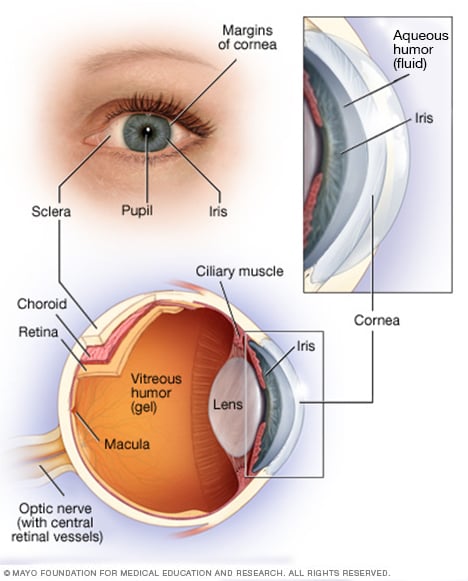Overview
Anatomy of the eye

Anatomy of the eye
Your eye is a complex and compact structure measuring about 1 inch (2.5 centimeters) in diameter. It receives millions of pieces of information about the outside world, which are quickly processed by your brain.
Color blindness — or more accurately, poor or deficient color vision — is an inability to see the difference between certain colors. Though many people commonly use the term "color blind" for this condition, true color blindness — in which everything is seen in shades of black and white — is rare.
Color blindness is usually inherited. Men are more likely to be born with color blindness. Most people with color blindness can't distinguish between certain shades of red and green. Less commonly, people with color blindness can't distinguish between shades of blue and yellow.
Certain eye diseases and some medications also can cause color blindness.
Symptoms
You may have a color vision deficiency and not know it. Some people figure out that they or their child has the condition when it causes confusion — such as when there are problems differentiating the colors in a traffic light or interpreting color-coded learning materials.
People affected by color blindness may not be able to distinguish:
- Different shades of red and green
- Different shades of blue and yellow
- Any colors
The most common color deficiency is an inability to see some shades of red and green. Often, a person who is red-green or blue-yellow deficient isn't completely insensitive to both colors. Defects can be mild, moderate or severe.
When to see a doctor
If you suspect you have problems distinguishing certain colors or your color vision changes, see an eye doctor for testing. It's important that children get comprehensive eye exams, including color vision testing, before starting school.
There's no cure for inherited color deficiencies, but if illness or eye disease is the cause, treatment may improve color vision.
Causes
Seeing colors across the light spectrum is a complex process that begins with your eyes' ability to respond to different wavelengths of light.
Light, which contains all color wavelengths, enters your eye through the cornea and passes through the lens and transparent, jellylike tissue in your eye (vitreous humor) to wavelength-sensitive cells (cones) at the back of your eye in the macular area of the retina. The cones are sensitive to short (blue), medium (green) or long (red) wavelengths of light. Chemicals in the cones trigger a reaction and send the wavelength information through your optic nerve to your brain.
If your eyes are normal, you perceive color. But if your cones lack one or more wavelength-sensitive chemicals, you will be unable to distinguish the colors red, green or blue.
Color blindness has several causes:
Inherited disorder. Inherited color deficiencies are much more common in males than in females. The most common color deficiency is red-green, with blue-yellow deficiency being much less common. It is rare to have no color vision at all.
You can inherit a mild, moderate or severe degree of the disorder. Inherited color deficiencies usually affect both eyes, and the severity doesn't change over your lifetime.
- Diseases. Some conditions that can cause color deficits are sickle cell anemia, diabetes, macular degeneration, Alzheimer's disease, multiple sclerosis, glaucoma, Parkinson's disease, chronic alcoholism and leukemia. One eye may be more affected than the other, and the color deficit may get better if the underlying disease can be treated.
- Certain medications. Some medications can alter color vision, such as some drugs that treat certain autoimmune diseases, heart problems, high blood pressure, erectile dysfunction, infections, nervous disorders and psychological problems.
- Aging. Your ability to see colors deteriorates slowly as you age.
- Chemicals. Exposure to some chemicals in the workplace, such as carbon disulfide and fertilizers, may cause loss of color vision.
Dec. 28, 2019